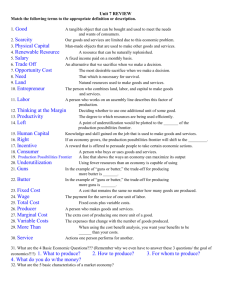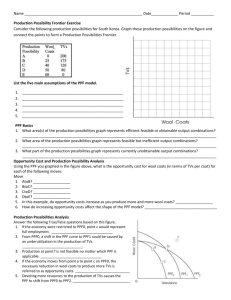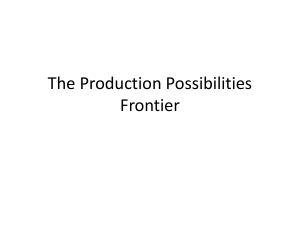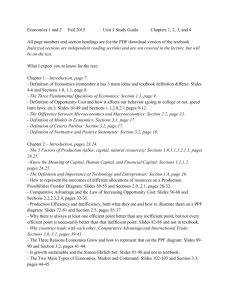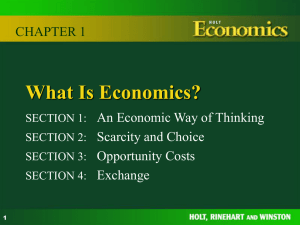Economics - Taft College
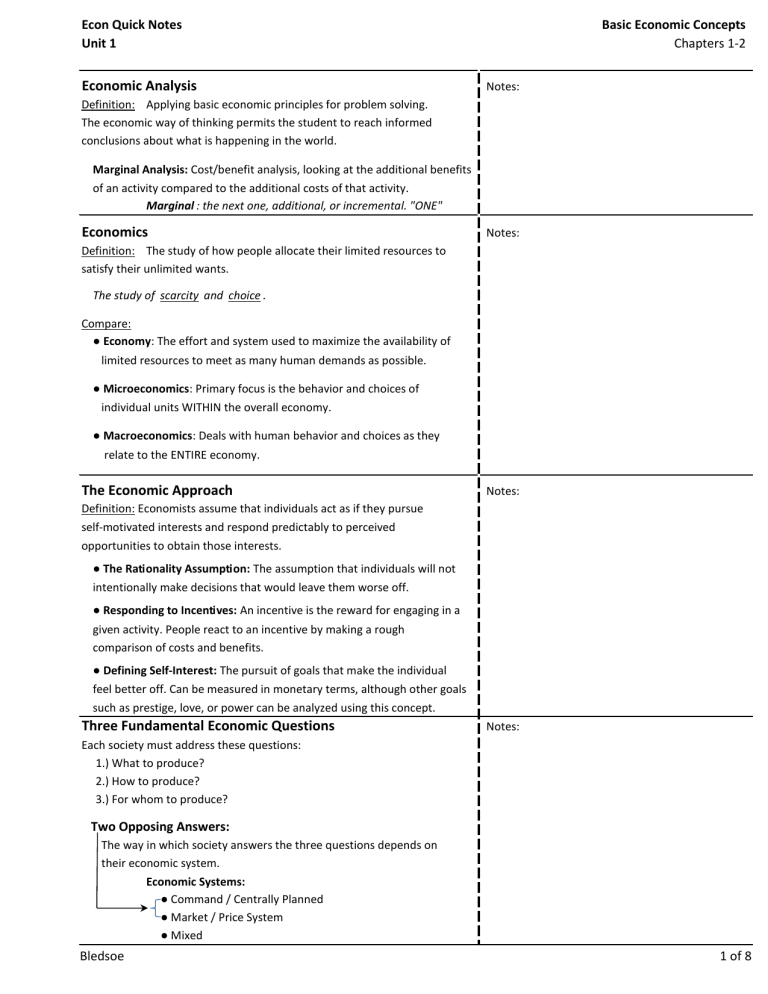
Econ Quick Notes
Unit 1
Economic Analysis
Definition: Applying basic economic principles for problem solving.
The economic way of thinking permits the student to reach informed conclusions about what is happening in the world.
Notes:
Marginal Analysis: Cost/benefit analysis, looking at the additional benefits
of an activity compared to the additional costs of that activity.
Marginal : the next one, additional, or incremental. "ONE"
Economics
Definition: The study of how people allocate their limited resources to satisfy their unlimited wants.
Notes:
The study of scarcity and choice .
Compare:
● Economy : The effort and system used to maximize the availability of
limited resources to meet as many human demands as possible.
● Microeconomics : Primary focus is the behavior and choices of
individual units WITHIN the overall economy.
● Macroeconomics : Deals with human behavior and choices as they
relate to the ENTIRE economy.
The Economic Approach
Definition: Economists assume that individuals act as if they pursue self-motivated interests and respond predictably to perceived opportunities to obtain those interests.
● The Rationality Assumption: The assumption that individuals will not
intentionally make decisions that would leave them worse off.
● Responding to Incentives: An incentive is the reward for engaging in a
given activity. People react to an incentive by making a rough
comparison of costs and benefits.
● Defining Self-Interest: The pursuit of goals that make the individual
feel better off. Can be measured in monetary terms, although other goals
such as prestige, love, or power can be analyzed using this concept.
Three Fundamental Economic Questions
Each society must address these questions:
1.) What to produce?
2.) How to produce?
3.) For whom to produce?
Two Opposing Answers:
The way in which society answers the three questions depends on
their economic system.
Economic Systems:
● Command / Centrally Planned
● Market / Price System
● Mixed
Bledsoe
Notes:
Notes:
Basic Economic Concepts
Chapters 1-2
1 of 8
Econ Quick Notes
Unit 1
Basic Economic Concepts
Chapters 1-2
Command or Centrally Planned Economic System
● Government answers the three fundamental economic questions.
● Communism and Socialism
- Lacks individual incentives
Market or Price Economic System
● Individuals answer the three fundamental economic questions.
● Prices in a market system signal relative scarcity of different resources,
which in turn provides information about what and how many items.
● Capitalism
Property Rights
Definition: Establish ownership and grant individuals the right to trade
goods and services with each other.
● Incentives matter & property rights provide incentives.
- Capitalism is a belief system that revolves around private ownership
of the economic resources and free labor (ability to work for wages).
Adam Smith
● Scottish philosopher - "Father of Modern Economics"
Notes:
● The Wealth of Nations (1776)
- Describes how a market system can flourish.
- Claims workers should specialize to become more productive.
- Higher productivity increase the overall wealth of the nation.
● Laissez Faire
- "let them do as they please"
- Smith called for restricting the role of government in the economy.
- Argues that individuals must be as free as possible to pursue their
own interests if a market economy is to run smoothly.
Circular Flow Diagram of a Market Economy
Definition: Shows the interactions between households and firms in a
free market economy.
● Households own the factors of production.
● Firms are organizations that use resources to produce a good or
service in which they attempt to sell for a profit.
● Invisible hand
- Smith noticed that businesses could provide
the goods and services consumers needed
without the help of a central plan.
- Guides a nations resources to their most
productive use, maximizes social welfare.
Key Components:
Self Interest: Individuals that each pursue what is best for themselves will ultimately make decisions that benefit the nation.
Competition: When businesses try and raise prices to high, another will enter the market and compete by lowering prices.
PRODUCT MARKET
$
MONETARY FLOW
PHYSICAL
FLOW
Product Market
● Households pay firms for goods and services (monetary flow).
● Firms supply household with goods and services (physical flow).
HOUSEHOLDS FIRMS
PHYSICAL
FLOW
Factor Market
● Households supply firms with the factors of production (physical flow).
● Firms pay households for the factors of production (monetary flow).
MONETARY FLOW
$
FACTOR MARKET
Bledsoe 2 of 8
Econ Quick Notes
Unit 1
Mixed Economic System
● Modern economies are a combination of the three previous
economic systems.
● Continuum can be formed with some countries more on the
centrally planned end and others closer to the free market end.
Notes:
Economics as a Science
Definition: Economics is a social science that utilizes the same types of methods used in biology, chemistry, and physics. Economic models or theories, which are simplified representations of the real world, are developed and used as aids in understanding, explaining, and predicting economic phenomena in the real world.
● Models and Realism: Every model in every science requires
simplification compared to the real world.
● Assumptions: Define the set of circumstances in which a model is most
likely to be applicable. Models must be based on a set of assumptions.
Ceteris Paribus Assumption: All Other Things Being Equal.
It is used to isolate the effect of a change in one variable on another
one by assuming that all other variables do not change.
● Deciding on the Usefulness of a Model: A model is useful if it yields
usable predictions supported by real-world observations (empirical science).
● Models of Behavior, Not Thought Processes: Models relate to the way
people act in using limited resources and not to the way they think.
Notes:
Behavioral Economics and Bounded Rationality: An approach to consumer behavior that emphasizes psychological limitations and complications that potentially interfere with rational decision making.
1. Bounded Rationality: The idea that people are nearly, but not fully,
rational so that they cannot examine every choice available to them but
instead use simple rules of thumb to sortamong the alternative available
to them.
2. Rules of Thumb: A simplified method of decision making. An important
issue is that persons who appear to use rules of thumb may behave as if
they are fully rational.
3.
Behavioral Economics: A Work in Progress: So far, proponents of
behavioral economics have not conclusively demonstrated that paying
closer attention to psychological thought processes can improve economic
predictions.
Positive versus Normative Economics
● Positive Economics : The branch of economic analysis that describes
the way the economy actually works.
- Attempts to describe what is.
● Normative Economics : Makes prescriptions about the way the
economy should work.
- Addresses what should be.
Bledsoe
Notes:
Basic Economic Concepts
Chapters 1-2
3 of 8
Econ Quick Notes
Unit 1
Basic Economic Concepts
Chapters 1-2
Scarcity
Definition: Limited quantities of resources to meet unlimited wants.
Characteristics:
● Limited
● Desirable
A scarce resource is not available in sufficient quantities to satisfy all the various ways society wants to use it.
Scarcity is not poverty. High incomes do not reduce scarcity.
Compare:
● Shortage : A situation in which a good or service is temporarily
unavailable.
The Crucial Problem of Economics
Definition: How to all allocate limited resources to unlimited wants.
Therefore, scarcity is the fundamental economic problem.
Resource: Anything that can be used to produce a good or service.
Wants vs. Needs: Needs are not objectively definable. Perhaps the best way to view a need is as an absolute necessity to stay alive. Wants refer to desired goods and are unlimited.
● Scarcity creates:
- Choice
- Competition
- The need for a rationing device
A rationing device is a means for deciding who gets what quantities of the available resources and goods.
Factors of Production
Definition: The economy's resources: land, labor, capital, and entrepreneurship.
Land: All resources that come from nature.
Labor: The effort of workers.
Capital : In economics there are two types of capital.
Note: Financial capital ($) is NOT one of them.
Physical Capital: Often referred to simply as "capital"-consists of
manufactured productive resources such as equipment, buildings,
tools, and machines.
Human Capital: The improvement in labor created by education and
knowledge that is embodied in the workforce.
Entrepreneurship: Describes the efforts of individuals in organizing resources
for production, taking risks to create new enterprises, and innovating to
develop new products and production processes.
Bledsoe
Notes:
Notes:
What is the rationing device in our society?
Notes:
4 of 8
Econ Quick Notes
Unit 1
Basic Economic Concepts
Chapters 1-2
Opportunity Cost
Definition: The most desirable alternative forfeited when a choice is made.
"2nd best choice"
● Explicit costs : Direct, purchased, out-of-pocket costs.
● Implicit costs : Indirect, non-purchased, opportunity costs.
Notes:
Mathematical Term: Total Opportunity Cost = Total Explicit Cost +
Total Implicit Cost
Trade-off
Definition: All the alternatives forfeited when a choice is made.
Notes:
"TINSTAAFL"
Production Possibilities Curves
Definition: Shows the combination of two goods that can be produced if an individual/economy uses all its resources fully and efficiently.
● Production Possibilities Frontier (PPF) : The line that represents
the combination of goods and services that can be produced.
- It represents the resources available to an economy or individual.
● Points : Represent production alternatives, not prices.
Assumptions Underlying the Production Possibilities Curve:
1. Resources are fully employed.
2. Production takes place over a specific time period—for example, 1 year.
3. Resources are fixed in both quantity and quality.
4. Technology does not change over this period of time.
a. Technology is defined as society’s pool of applied knowledge
concerning how goods and services can be produced.
Graph:
100
Represents basic economic problem of scarcity.
A
D
C
PPF
B
BUTTER
Represents Consumer Goods
E
100
Notes:
Production Possibilities Curves - Efficiency
● Productive Efficiency : Producing the maximum output given the level
of resources. All points on the frontier are productively efficient.
- Which points are productively efficient?
● Allocative Efficiency : Producing the optimal output (combination of
goods that provide the greatest benefit).
- Which points are allocatively efficient?
Graph:
100
A
D
C
PPF
B
E
BUTTER 100
If asked to identify which points are efficient, assume productive efficiency.
Notes:
Efficiency is also a situation in which a given output is produced at a minimum cost. An economy is efficient when it is on its PPC. An inefficient point is any point below theproduction possibilities curve.
Bledsoe 5 of 8
Econ Quick Notes
Unit 1
Production Possibilities Curves - Unemployed vs. Unattainable
Graph:
100
● Unemployed : Resources that are not being used or are underutilized.
All points to the left of the frontier are considered an inefficient use
of resources.
- Which point(s) represent unemployment or inefficient use of
resources?
● Unattainable : Production possibilities that are currently not possible
given the level of resources. All points to right of the frontier are
currently unattainable.
- Which point(s) are unattainable?
Notes:
Basic Economic Concepts
Chapters 1-2
A
D
C
B
BUTTER
PPF
E
100
Production Possibilities Curves - Constant Opportunity Cost
● Calculating Opportunity Cost : Delta (∆) = Change
- For Good X use the slope of the PPF: ∆Y / ∆X
- For Good Y use the inverse of the slope of the PPF: ∆X / ∆Y
Example 1:
1.) What is the opportunity cost of good X?
Example 1:
30
Resources are equally suited, opportunity cost is constant.
25
A
B
20
15
10
5
C
D
0
E
PPF
F
5 10 15 20 25
Good X
2.) What is the opportunity cost of good Y?
Example 2:
3.) How would you solve for the opportunity cost of a table?
4.) How would you solve for the opportunity cost of a desk?
Example 2:
30
25
20
15
10
5
A
Resources not equally suited, opportunity cost still constant.
B
0
C
5 10 15 20 25
Desks
PPF
Notes:
Bledsoe
5.) Solve:
Opportunity cost of a table =
Opportunity cost of a desk =
6 of 8
Econ Quick Notes
Unit 1
Basic Economic Concepts
Chapters 1-2
Production Possibilities Curves - Increasing Opportunity Cost
Example 1:
● Law of Increasing Costs: the more of a good that is produced the
30
A
greater its opportunity cost.
- This occurs when resources are not perfectly adaptable to
alternative uses.
- Will cause the PPF to be concave to its origin, or bow out.
25
20
15
10
5
Said another way:
The Law of Increasing Additional Cost: The fact that the opportunity cost of
0 additional units of a good generally increases as society attempts to produce more of that good. This accounts for the bowed-out shape of the production possibilities curve.
Example 2:
B
E
C
F
PPF
5 10 15 20 25 30
D
Blu-Ray Players
Example 1:
1.) How would you solve for the opportunity cost of a computer?
Guns
0
2
4
Butter
10
6
0
2.) How does the opportunity cost of computers change?
When moving from point B to A =
When moving from point C to B =
When moving from point D to C =
8.) What is the maximum number of guns that can be produced?
3.) Which has the greater opportunity cost, producing the 1st or last computer? Explain.
9.) If the maximum number of guns are produced, how much butter could be produced?
10.) What is the maximum units of butter that can be produced?
4.) How would you solve for the opportunity cost of a blu-ray?
11.) If the maximum units of butter are produced, how many guns could be produced?
5.) How does the opportunity cost of blu-ray players change?
When moving from point A to B =
When moving from point B to C =
When moving from point C to D =
6.) Which has the greater opportunity cost, producing the 1st or last blu-ray player? Explain.
12.) The opportunity cost of producing the first two units of guns is how many units of butter?
12.) What is the opportunity cost of producing the first unit of guns?
13.) What is the opportunity cost of producing the first unit of butter?
7.) Which point has the lowest opportunity cost. Explain.
Bledsoe 7 of 8
Econ Quick Notes
Unit 1
Production Possibilities Curves - Preferred Points
Explanation: We can only say a point is preferred to another if it is attained at a zero opportunity cost.
1.) Which point(s) would be preferred to point F?
2.) On the graph shade in the area that would represent all points that would be preferred to point F.
Example:
30
25
20
15
10
5
A
0
B
C
D
F
E
PPF
5 10 15 20 25 30
Corn
Production Possibilities Curves - Shifts of the Frontier
Example 1:
•As an economy grows, its PPF shifts outwards
Growth can result from:
- the discovery or acquisition of new resources (land)
- growth in the labor force, an increase in the skills and abilities of
the labor force (labor)
- technological change or an increase in the amount or quality of
productive equipment available (capital)
Moving from point A to point B represents economic growth, as it would only be possible with a shift of the frontier.
Example 1:
Basic Economic Concepts
Chapters 1-2
A
C
B
Education
PPF
1
PPF
2
Moving from point A to point C represents a change in allocation of resources, NOT economic growth.
Example 2: Example 2:
•As an economy contracts, its PPF shifts inwards
Contraction can result from:
- Natural disasters
- Loss of life and property (war, terrorism, etc.)
- A persistent economic recession (depression)
Most recessions result in unemployment of resources
Moving from point A to point B represents unemployment, NOT a shift of the frontier.
A
B
PPF
2
Butter
PPF
1
Example 3: Example 3:
•Technological change in only one type of production can free up resources that can be used in the production of other goods and services
- Even though there were no direct improvements in the production
of health care, increased capabilities in education allow the
country to have more of both!
1.) Do the examples presented represent constant or increasing opportunity cost? Explain.
A
B
Education
PPF
1
PPF
2
Bledsoe 8 of 8
